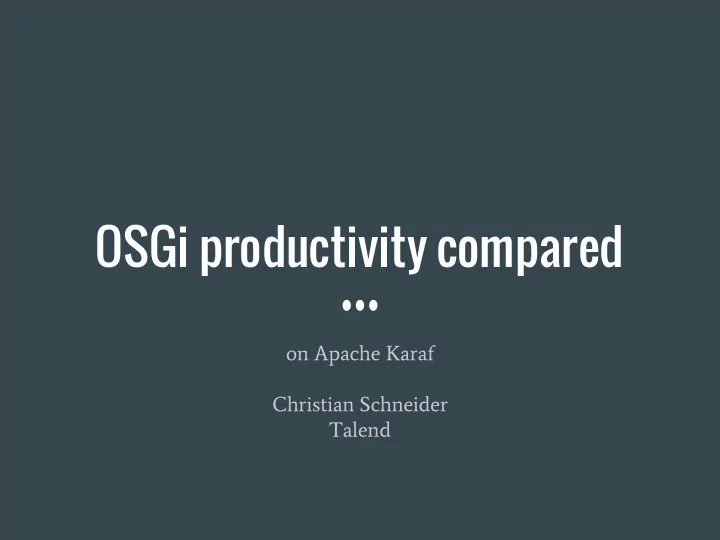

OSGi productivity compared on Apache Karaf Christian Schneider Talend
Goals Introduce Declarative Services and Blueprint ● Model a simple enterprise application in both frameworks regarding ● Configuration ○ JPA and Transactions ○ Rest and SOAP ○ Packaging / Deployment for Apache Karaf ● Eclipse without PDE ● Recommendations ● Future enhancements ●
Sample Application Tasklist UI Servlet OSGi service Persistence Service Endpoint JPA REST TaskServiceImpl Model Task Entity TaskService interface
Declarative Services (DS) Component <-> Class <-> XML descriptor ● Annotations -> XML at build time ● Dynamic Lifecycle ● Pro Annotations standardized ● Very small at runtime (Just one bundle) ● Con No support for interceptors ● No extension model ●
DS Component Lifecycle Component A Service B Component A Service B Will activate when all dependencies are present Component A Service B Will deactivate when any mandatory dependency goes away
DS Example Create OSGi Service @Component public class InitHelper { TaskService taskService; Called on start of component @Activate public void addDemoTasks() { Task task = new Task(1, "Just a sample task", "Some more info"); taskService.addTask(task); } Mandatory OSGi service reference @Reference public void setTaskService(TaskService taskService) { this.taskService = taskService; } }
(Aries) Blueprint Beans described in a XML Context ● Annotations -> XML at build time ● Config per Context, injected into properties ● Pro Extension model using Namespaces ● Many Extensions (Aries JPA, Aries Transaction, CXF, Camel, Authz) ● Supports internal wiring (DI) ● Supports interceptors (e.g. for transactions) ● Con No standard blueprint annotations ● Lifecycle per Context ● Service damping ●
Blueprint Lifecycle Graceperiod when mandatory services missing Permanent failure after timeout Context A Service B Context A Service B Will activate when all mandatory dependencies are present Context A Service B Will block if mandatory service goes away
Blueprint Example <blueprint xmlns="http://www.osgi.org/xmlns/blueprint/v1.0.0"> <bean id="initHelper" class="net.lr.tasklist.persistence.impl.InitHelper" init-method=" Create bean addDemoTasks"> Called on start of bean <property name="taskService" ref="taskService"/> Inject another bean </bean> <reference id="taskService" interface="net.lr.tasklist.model.TaskService"/> </blueprint> Mandatory OSGi service reference <blueprint xmlns="http://www.osgi.org/xmlns/blueprint/v1.0.0" > <bean id="taskServiceImpl" class="net.lr.tasklist.persistence.impl.TaskServiceImpl" ext: field-injection="true"/> <service ref="taskServiceImpl" interface="net.lr.tasklist.model.TaskService"/> </blueprint> Publish bean as OSGi service
Blueprint from CDI annotations Uses subset of CDI ● Aims for compatibility with real CDI runtime ● CDI + JEE + pax-cdi Annotations blueprint-maven-plugin blueprint xml
Blueprint from CDI annotations Example Publish as OSGi service @OsgiServiceProvider(classes = {TaskService.class}) @Singleton Create bean public class TaskServiceImpl implements TaskService { } Inject OSGi Service @Singleton Inject another bean public class InitHelper { @OsgiService @Inject TaskService taskService; @PostConstruct Called on start of context public void addDemoTasks() { Task task = new Task(1, "Just a sample task", "Some more info"); taskService.addTask(task); } }
Configuration Goals Configure objects from config admin configurations ● Support configuration changes at runtime ● Ideally support type safety and config validation (meta type spec) ●
Configuration in DS (1.3) @ObjectClassDefinition(name = "Server Configuration") Meta type definition @interface ServerConfig { String host() default "0.0.0.0"; int port() default 8080; boolean enableSSL() default false; } @Component @Designate(ocd = ServerConfig.class) link with config metadata public class ServerComponent { @Activate public void activate(ServerConfig cfg) { Type safe configuration ServerSocket sock = new ServerSocket(); called when config changes sock.bind(new InetSocketAddress(cfg.host(), cfg.port())); } } Example from http://njbartlett.name/2015/08/17/osgir6-declarative-services.html
Configuration in blueprint In Apache Karaf config would be in /etc/com.example.config.cfg <cm:property-placeholder persistent-id="com.example.config" update-strategy="reload"> <cm:default-properties> <cm:property name="host" value="0.0.0.0" /> Blueprint context restarted on <cm:property name="port" value="8080" /> config change </cm:default-properties> </cm:property-placeholder> Default value <blueprint xmlns="http://www.osgi.org/xmlns/blueprint/v1.0.0" > <bean id="taskServiceImpl" class="net.lr.tasklist.persistence.impl.TaskServiceImpl"> <property name=”host” value=”${host}”/> Inject into property with <property name=”port” value=”${port}”/> automatic type conversion </bean> </blueprint> No real meta type support
JPA and Transactions - Persistence Unit Aries JPA Container implements the OSGi JPA Service Specification. DataSource Service DataSource name Bundle A Meta-Persistence: META-INF/persistence.xml PersistenceProvider Service Hibernate Persistence Provider name Scans for bundles with persistence units Creates services in Aries JPA the name of Bundle A EntityManagerFactory EntityManager JpaTemplate
Closure based transactions for DS or Blueprint @Component public class TaskServiceImpl implements TaskService { private JpaTemplate jpa; public Task getTask(Integer id) { return jpa.txExpr(TransactionType.Supports, em -> em.find(Task.class, id)); } public void updateTask(Task task) { jpa.tx(em -> em.persist(task)); } @Reference(target = "(osgi.unit.name=tasklist)") public void setJpaTemplate(JpaTemplate jpa) { this.jpa = jpa; } }
Declarative transactions for Blueprint @Singleton All methods run in transaction by default @Transactional public class TaskServiceImpl implements TaskService { Managed EM injected @PersistenceContext(unitName = "tasklist") EntityManager em; No Transaction required here @Transactional(TxType.SUPPORTS) public Task getTask(Integer id) { return em.find(Task.class, id); } public void updateTask(Task task) { em.persist(task); } }
REST and SOAP Services Use OSGi remote services (Apache CXF DOSGi or Eclipse ECF) Annotate Class with @WebService or Rest annotations ● Export as OSGi service with special properties ● JAX-RS connector by Eclipsesource (Holger Staudacher) Scans for OSGi services of JAX-RS classes ● Provides security and different serializations ● Easy to install in Apache Karaf with a feature ●
REST and SOAP Service in blueprint using Apache CXF Custom Aries blueprint namespace ● No pure Annotation based configs ● Several protocols http, servlet, jms, local, … ● Extensive Security Features ● Enterprise level logging to Elasticsearch leveraging Karaf Decanter ●
REST Service in Blueprint using CXF <bean id="personServiceImpl" class="net.lr.tutorial.karaf.cxf.personrest.impl.PersonServiceImpl"/> <jaxrs:server address="/person" id="personService"> <jaxrs:serviceBeans> <ref component-id="personServiceImpl" /> Class with JAXRS annoations </jaxrs:serviceBeans> <jaxrs:features> <cxf:logging /> Additional CXF features </jaxrs:features> </jaxrs:server>
SOAP Service in Blueprint using CXF <bean id="personServiceImpl" class="net.lr.tutorial.karaf.cxf.personservice.impl.PersonServiceImpl"/> <jaxws:endpoint implementor="#personServiceImpl" address="/personService" />
Packaging for Apache Karaf Pro User features can depend on other features to ease deployment ● Karaf provides features for most enterprise needs like (JPA, Transaction, CXF, ● Camel, ActiveMQ, Hibernate, OpenJPA, Eclipselink, Elastic Search) Feature validation at build time (Since Karaf 4) ● References to bundles and feature repos as maven coordinates ● Can leverage all bundles in any maven repo ● Con Karaf feature creation still largely manual ●
Recommend
More recommend